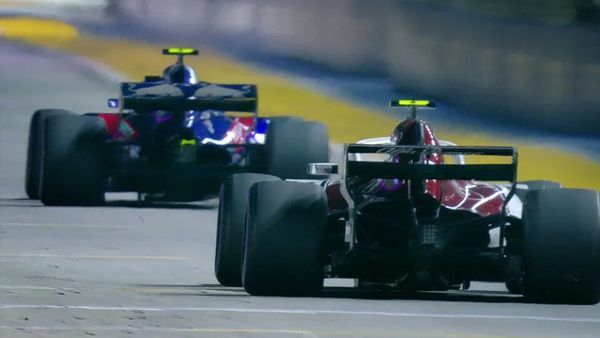Storytelling for Business: Drive to Survive, the Formula-1 Series
I want to explain which storytelling techniques were used by the new owners of the Formula-1 brand to create an image and attract the audience.
The new owners of Formula-1 faced a task that requires an extraordinary solution. It was necessary to give the racing series characters, show their unique features and make the viewer empathize to the 20 racers. Storytelling tools are perfectly suited for this task.
My name is Pavel Podobny, I am the coach of the BEsmart. We train public speaking skills, critical thinking and study various communication techniques, including storytelling. I want to explain which storytelling techniques were used by the new owners of the Formula-1 brand to create an image and attract the audience.
In 2016, the American corporation Liberty Media bought the company that managed Formula-1. The new owners immediately announced their desire to expand the global audience of the racing series.
Finding new Formula-1 viewers is a difficult task. In addition to competing with familiar to the USA NASCAR and IndyCar racing series, it is necessary to fight with other super-popular sports leagues in the West: NFL, NBA, MLB and NHL, and the entertainment industry in general.
In 2016, the American corporation Liberty Media bought the company that managed Formula-1. The new owners immediately announced their desire to expand the global audience of the racing series.
Finding new Formula-1 viewers is a difficult task. In addition to competing with familiar to the USA NASCAR and IndyCar racing series, it is necessary to fight with other super-popular sports leagues in the West: NFL, NBA, MLB and NHL, and the entertainment industry in general.
A casual viewer is not interested much in watching Formula-1 where cars drive along the highway for an hour and a half.
The names and identities of the drivers are also not familiar to a casual viewer, and even if they want to get to know them better, they will fail. There’s nothing on internet aside from pretty regular interviews of racers.
As a result, Liberty Media bought a really complicated product. The new owners of Formula-1 faced a task that requires an extraordinary solution. It was necessary to give the racing series characters, show their unique features and make the viewer empathize to the 20 racers.
Storytelling tools are perfectly suited for this task. Brands all over the world always use stories to gain product loyalty. We love stories.
As a result, Liberty Media bought a really complicated product. The new owners of Formula-1 faced a task that requires an extraordinary solution. It was necessary to give the racing series characters, show their unique features and make the viewer empathize to the 20 racers.
Storytelling tools are perfectly suited for this task. Brands all over the world always use stories to gain product loyalty. We love stories.
Liberty Media had to create an earth-shattering story
in order to compete.
in order to compete.
Jointly with Netflix such story was created under the name «Drive to Survive». They managed to turn Formula-1 into reality show which helped to attract new viewers. Using the example of one of the main characters — Pierre Gasly, let’s figure out which storytelling tools were used there.
The Context
The world of Formula-1 is a symbiosis of money, technology and personalities. It’s difficult to understand immediately. «Drive to Survive» shows us this world carefully, consistently highlighting the key details for the development of the plot from simple to complex ones.
Firstly, they show us that being a Formula-1 driver is complicated and life-threatening. You have to work really hard to be among the best.
Then we find out that even this may not be enough — teams need a lot of money to exist. So that’s the reason why talented drivers fail to compete with other who have more sponsorship.
In addition to this, we understand that it’s not enough to be just a good driver to achieve success. A lot of people are responsible for the result: team leaders, car designers, mechanics. Even the careers of racers depend on how well they all do their job.
Firstly, they show us that being a Formula-1 driver is complicated and life-threatening. You have to work really hard to be among the best.
Then we find out that even this may not be enough — teams need a lot of money to exist. So that’s the reason why talented drivers fail to compete with other who have more sponsorship.
In addition to this, we understand that it’s not enough to be just a good driver to achieve success. A lot of people are responsible for the result: team leaders, car designers, mechanics. Even the careers of racers depend on how well they all do their job.
«Drive to Survive» explains the rules of the Formula-1 world — it’s highly competitive, unfair world where the price of a mistake is extremely high.

Frame from the movie Drive to Survive
The Character
To create a really interesting story, there should be a character or a group of characters.
What does provoke the viewer to feel empathy? The character traits, the context in which he is placed. The audience associates themselves with him, lives through the events he encounters in the story.
What does provoke the viewer to feel empathy? The character traits, the context in which he is placed. The audience associates themselves with him, lives through the events he encounters in the story.
The moment of acquaintance is a crucial part in the story. It is important not just to tell about the hero, but to give the viewer the opportunity to form an opinion about him based on the context and circumstances.
We see Pierre Gasly in episode 8, season 1. By this point, we already know that Formula-1 is a highly competitive environment in which it is easy to lose a place. The Red Bull system sets the highest requirements for its drivers and does not forgive mistakes.
What do we learn about Pierre when we meet? Firstly, he is a very talented driver — his successful performances illustrate this fact. Secondly, Pierre is purposeful — they show us his way from karting competitions, and we understand that from early childhood Pierre went to a place in Formula-1.
Thirdly, Pierre works out hard. He is also the future driver of Red Bull, one of the strongest Formula-1 teams.
What do we learn about Pierre when we meet? Firstly, he is a very talented driver — his successful performances illustrate this fact. Secondly, Pierre is purposeful — they show us his way from karting competitions, and we understand that from early childhood Pierre went to a place in Formula-1.
Thirdly, Pierre works out hard. He is also the future driver of Red Bull, one of the strongest Formula-1 teams.
«Drive to Survive» explains the rules of the Formula-1 world — it’s highly competitive, unfair world where the price of a mistake is extremely high.

Pierre Gasly is a French racing driver
The talent, hard work — all these are qualities that we value in people and that we would like to possess ourselves. They show us that Pierre is a cool guy who deserves success, and we hope that he will achieve it.
The Plot
All archetypal plots tell how the character goes through the path, encountering the surrounding context and circumstances.
All archetypal plots tell how the character goes through the path, encountering the surrounding context and circumstances.
We get to know Pierre at the highest point of his success. He became a driver of the main Red Bull team, achieved the goal he had been striving for all his life.
In the second season the story of Pierre develops, moving down. Netflix smoothly shows the failures of him, the increasing pressure from the team. We understand what emotions Pierre experiences.
The climax happens in the middle of the second season when Pierre loses the place in a team, and his friend dies in a race. It’s the most important moment in a story. But why?
The viewers associate themselves not with the specific situation, but with the general nature of circumstances. If we know the context then we understand the importance of events for the character. We try the emotions that he experiences at that moment on.
None of us has experienced the loss of the place in Red Bull team, but the fear to not living up expectations or to loose status are familiar to everyone.
A good story abstracts from a specific situation and lands it at the level of emotions. This is the only way to provoke empathy.
We get to know Pierre at the highest point of his success. He became a driver of the main Red Bull team, achieved the goal he had been striving for all his life.
In the second season the story of Pierre develops, moving down. Netflix smoothly shows the failures of him, the increasing pressure from the team. We understand what emotions Pierre experiences.
The climax happens in the middle of the second season when Pierre loses the place in a team, and his friend dies in a race. It’s the most important moment in a story. But why?
The viewers associate themselves not with the specific situation, but with the general nature of circumstances. If we know the context then we understand the importance of events for the character. We try the emotions that he experiences at that moment on.
None of us has experienced the loss of the place in Red Bull team, but the fear to not living up expectations or to loose status are familiar to everyone.
A good story abstracts from a specific situation and lands it at the level of emotions. This is the only way to provoke empathy.
Pierre Gasly’s story is the story of success. But almost every story of success has its own ups and downs. We need to show what made an impact on the main character, and what traits helped him to overcome the obstacles.
Netflix shows us a really strong personality of Pierre. Even when he loses everything, he doesn’t give up and keeps on moving forward. After all he wins the race.
Not only Pierre is happy. We all are happy for him as we believe he deserves success.
Not only Pierre is happy. We all are happy for him as we believe he deserves success.
To Make a Good Story, You Need:
- A character or a group of characters. Their qualities, character traits, personalities should be clear. It’s better if the audience makes an opinion by themselves.
- The Context. A character always exists in the context that surrounds him. Context influences his behavior and emotions. What is important to build a context?
- The scale of events. Sometimes the situations in which the hero finds himself are not familiar to us in everyday life. To achieve empathy from the audience, it is necessary to show the scale of individual events within the context in which the hero is placed. If the viewer, listener or reader understands the importance of what is happening, it is easier for him to associate his emotions in similar situations with the emotions of the hero. Also details provide information about the context and characters, making them realistic.
- The Plot. There are different archetypes of stories, but in each of them the state of the hero changes — the more contrasting these changes are, the more interesting it is to follow the plot.
Since 2018, the audience of Formula-1 has been growing continuously. The races attract a lot of young viewers. More recently, faceless racers and teams have gained character, become recognizable and have fans.

